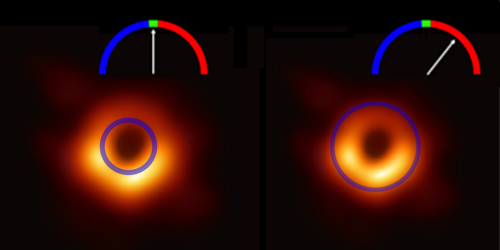Putting the Squeeze on General Relativity
In 2019, the Event Horizon Telescope (EHT) released the first image of a giant black hole in the nearby galaxy M87. Revealing a circular shadow whose diameter was within 17% of predictions, the measurement provided a qualitative confirmation of general relativity while still leaving room for alternative theories of gravity. Now, a more detailed analysis by the EHT Collaboration shows that the shadow’s shape can provide quantitative constraints on these alternative models. The work represents a test of Einstein’s theory in strong-field regimes that have never been explored [1].
General relativity has passed countless tests with flying colors. Most tests have been performed under the weak gravitational fields found within our Solar System. However, deviations from relativity might only appear in stronger gravity. LIGO and Virgo’s recent observations of black hole mergers have probed stronger-field regimes, showing that the theory holds in the curved spacetime of black holes as heavy as about 150 Suns. With M87, which is over six billion times heavier than the Sun, the researchers have extended these tests to a radically different spacetime.
Considering two distinct alternative models of gravity, the team found that the models’ respective deviations from relativity in strong fields would show up in the same parameters. These parameters—appearing in approximations of Newtonian gravity that account for observed relativistic effects—are directly related to the shadow’s shape (as the researchers explain in a video). Using this information, the researchers calculated constraints on deviations from relativity that are comparable in magnitude to those derived from gravitational-wave tests. Once EHT releases the image of Sagittarius A*—the black hole at our Galaxy’s center—these constraints will become much tighter, says EHT team member Dimitrios Psaltis of the University of Arizona.
Correction (2 October 2020): The text was updated to describe the spacetime around M87 as “radically different” from the spacetime around the Sun instead of “more radically warped.”
–Matteo Rini
Matteo Rini is the Editor of Physics Magazine.
References
- D. Psaltis et al., “Gravitational test beyond the first post-Newtonian order with the shadow of the M87 black hole,” Phys. Rev. Lett. 125, 141104 (2020).




